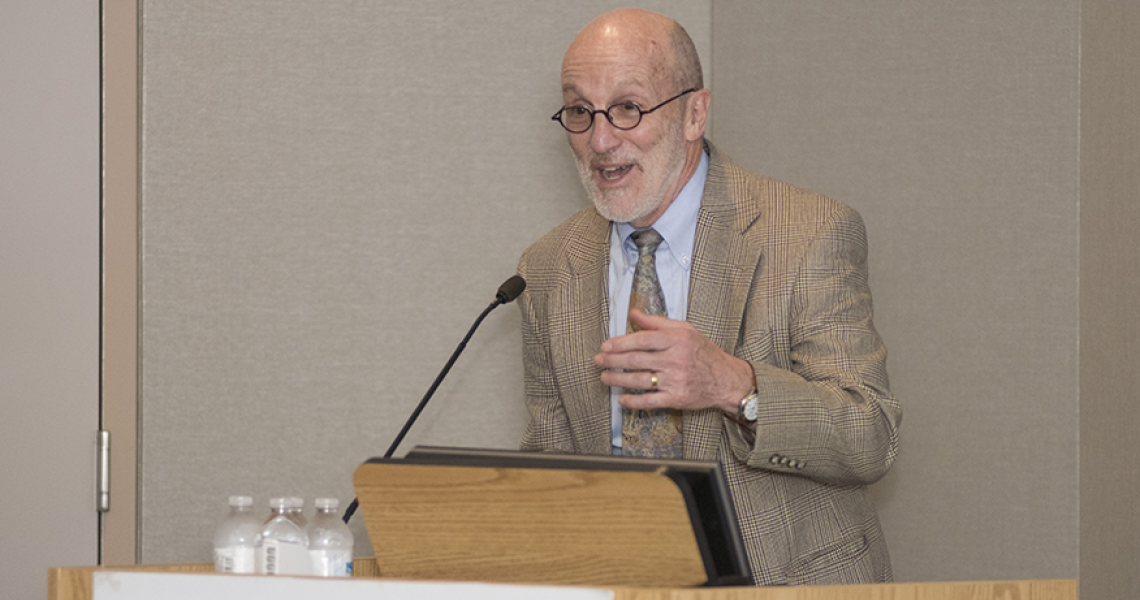It’s a part of practicing medicine that has nothing to do with science and everything to do with emotion: delivering bad news. Word choice, said Timothy E. Quill, MD, a physician in the Division of Palliative Care at the University of Rochester Medical Center, is powerful, and with it clinicians wield substantial influence. So how can professionals verbally practice the art of empathy? By employing a set of practical phrases.
“There are things you can [say], even on a bad day, and people will understand that you know what they’re going through,” explained Quill, whose lecture, “Words That Matter: Some Relatively Simple Palliative Care Communication Strategies That Can Make a Difference,” was the focus of the Second Annual Ronald L. Ottenberg Memorial Lecture/Grand Rounds on Doctor-Patient Communication.
According to Quill, there are three main instances in which clinicians can reframe their approaches to dialogue: wish statements; discussion of prognoses; and negotiations with patients who “want everything.”
“Wishes are statements of empathy that acknowledge something about the emotion that’s going on when things aren’t going well,” Quill explained. “It really is an expression of you as a human being, and it simultaneously and paradoxically identifies with what is usually an unrealistic hope.”
He advises use of ambiguous statements that subtly indicate that what is mutually hoped for is unlikely; for example, “I wish I had better news to give you,” “I wish things had turned out differently,” “I wish our palliative treatments were more effective,” “I wish we had a universal health care.” Acknowledging medicine’s limitations allows the clinician to enter the patient’s world.
Using those statements while discussing a negative prognosis can also be helpful, though Quill urges that clinicians need to go prepared into any conversation with patients.
“You want to make sure you’ve got your facts correct … and estimate an average survival and a ballpark range,” he said, adding that inviting key people — members of the care team, members of the patient’s family — is equally important. “We use the Ask-Tell-Ask [strategy]. Particularly with things like prognoses, that are pushing the envelope, we can ask people ‘would you like to know what we know about your prognosis,’ and they can say no.”
Take, for instance, Patient X, a 25-year-old white male, the father of two kids, who has been diagnosed with malignant melanoma (Stage IIIB with two possible lymph nodes). His question? “What does this mean in terms of my future?”
With pairs in the lecture audience acting as patient and doctor, conversations concentrated on statistics, including average survival rates, and how to respond to emotional reactions. “Do you feel like you’re hurting the patient?” Quill asked after the role-playing. “There are different kinds of pain here. There is no pain-free way to go, [but these methods can help]. It’s hard, it’s super hard.”
Providing information in bite-sized pieces, and making sure all of the information is understood, can help mitigate miscommunication.
Likewise, when speaking with patients who “want everything,” it is important to use limit-setting strategies. Most of the time, “everything” comes up when there is a new diagnosis, treatment isn’t working, and hospice care is the likely next step, Quill said. When everything also means prolonging suffering while prolonging life, it’s important to have a conversation.
“In having this discussion, the biggest mistake I ever made was to not rehear the patient’s story,” Quill said. “If I’m new at this, I really need to hear their story. The more about that I know going into it, the better position [I’m in] to be effective when interacting with them.”
He also advocates for recommending a plan of treatment, which helps to take the burden of what to do next off of the patient and the family. The discussion also might entail defining any problems, goals, and the methods and conditions of treatment. The main thing to do, he added, is to try to get to yes.
Like one case, that of a 45-year-old woman, who had previously beaten two cancers. She had widely metastatic, non-small cell lung cancer and was unresponsive to third-line therapy. “She did not want to talk about her prognosis; she wanted everything,” Quill recalled. “The initial acceptance was that we would focus exclusively on pain and symptoms. … She was a fighter, she felt she could beat this. She’d been told things were hopeless in the past with her earlier cancers.”
Ten days later, he added, she got sicker, so he and his team proposed setting a limit on CPR and breathing machines; she agreed, provided he kept looking for treatments that might be effective. She eventually received chemotherapy as she got stronger, but ultimately she became less and less responsive.
“We shifted to a purely comfort-oriented approach with her family’s consent, and she died peacefully in the hospital several days later,” Quill said. “This would be a super successful palliative care case. We took a very hard case where we were at loggerheads, and we allowed her to get the treatment she wanted.”
